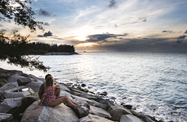With some of the most unspoilt rainforest left anywhere on Earth and a firm commitment by the government to keep them that way, Brunei Darussalam's pristine ecosphere has great potential to boost its tourism sector. It also presents a range of scientific research and development opportunities that could generate spin-offs in a number of industries.
Nowhere is the symbiosis between the Sultanate's forests and its economic future better illustrated than by the continuing efforts to explore and study the Sungai Ingei Protection Forest. Situated in the western Belait district, deep in the jungle close to the border with the Malaysian state of Sarawak, the large forest area has never been properly explored.
The Sungai Ingei region covers some 18,491 ha of the Labi Hills Forest Reserve, which lies adjacent to Sarawak's Gunung Mulu National Park, a UNESCO World Heritage site. The forest is a combination of three types of tropical environment: mixed dipterocarp forest (tall trees with a two-winged seed), freshwater swamp in the lower valleys and in the uplands Sundaland heath, a tropical, moist forest also known as Kerangas.
Sungai Ingei forms part of the Sultanate's extensive forest cover, which accounts for around 70% of the country's 5271 sq km of land area. The Sultanate has designated 32,000 ha of this land as forest reserves and 50,000 ha as national parks. It is now engaged in studying the natural life in these remote regions.
Deep in Singao Ingei, teams of researchers from the University of Brunei Darussalam (UBD), backed by the Ministry of Industry and Primary Resources and supported by the National Heart of Borneo (HoB) Council and World Wide Fund for Nature (WWF), are conducting Brunei Darussalam's first-ever biodiversity study.
The region's possible inhabitants includes rarely glimpsed animals such as the Borneo tarsier, the Borneo clouded leopard, the false gharial (a type of crocodile) and numerous types of forest-dwelling frogs and bats. The two-year study aims to garner the scientific data necessary to ensure full protection of Sungai Ingei, since there are plans for it to be designated as a national park, as well as improve the understanding of its ecosystem.
There is much talk of the forest's potential as an ecotourism destination, amid hope that it could follow in the footsteps of Ulu Temburong National Park in the south-east.
Ulu Temburong pioneered ecotourism in Brunei Darussalam in the last decade, and has since become one of the country's major tourism draws. The park contains some of the most pristine rainforest in the world, and has been sensitively developed to retain its untouched quality.
Ulu Temburong is also a showcase for Brunei Darussalam's commitment to the HoB project, a WWF-backed initiative under which the Sultanate, along with the governments of Malaysia and Indonesia, aim to conserve a total of 2m ha of equatorial rainforest through a network of protected areas and sustainably managed forest. This is an area equal to almost one-third of the island of Borneo, and somewhere in the range of 60% of Brunei Darussalam's entire landmass has been given over to the HoB initiative.
Potential for growth also exists in the area of scientific research and product development.
Ulu Temburong is already the location of a UBD field study complex, and it received a major boost recently when a new research centre into climate change was established with help from America's Smithsonian Institute. Biodiversity is one of the UBD's chief areas of focus, with the understanding that through researching the flora and fauna of a forest a whole range of products can be developed, from pharmaceuticals to food.
The Brunei Tourism Board is waiting for Sungai Ingei to receive its full designation as a national park. Once that happens, it will set up facilities and open up access to visitors. This will likely be by temuai, or long-boat, the traditional means of transport for the island's inland waterways, since the board's commitment to preserving the forest's untouched state means it must refrain from building new roads.

